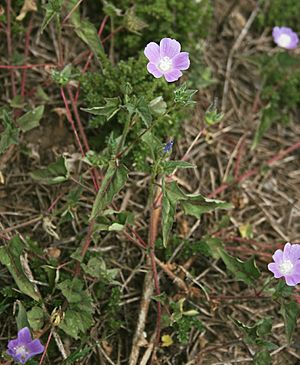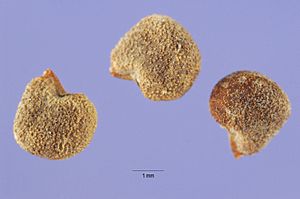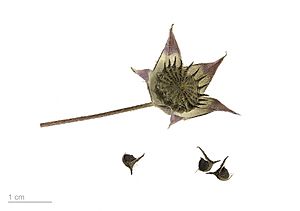Anoda cristata facts for kids
Quick facts for kids Anoda cristata |
|
|---|---|
 |
|
| Anoda cristata (L.) Schltdl. | |
| Conservation status | |
| Scientific classification | |
| Genus: |
Anoda
|
| Species: |
cristata
|
| Synonyms | |
|
|
Anoda cristata is a type of flowering plant. It belongs to the mallow family. People know it by several common names. These include spurred anoda, crested anoda, and violettas.
This plant originally comes from North and South America. It has spread to other parts of the Americas and Australia. In these new places, it is an introduced species. Sometimes, it grows so much that it becomes a weed. It has even been found growing as a weed in Belgium. You can often find Anoda cristata growing naturally near streams. It also likes moist meadows and areas where the ground has been disturbed.
Contents
What Anoda cristata Looks Like
This plant is an annual herb. This means it lives for only one growing season. It can grow to be about one half to one meter tall. That's about 1.5 to 3 feet high.
Stems and Leaves
The stem of the plant has ridges. It also has branches that spread out. The plant's shape can change a lot. This is especially true for its leaves. But usually, the leaves are somewhat shaped like a triangle. They also feel a bit hairy.
Flowers and Fruit
Single flowers grow where the leaves meet the stem. They are on long stems called pedicels. Each flower is about 2 to 3 centimeters wide. That's about 1 inch across.
The flower has pointed green or reddish sepals. These are like small leaves that protect the bud. It also has five petals. These petals can be a pretty bluish-purple or reddish-pink color.
After the flower blooms, it forms a fruit. This fruit is a round, disc-shaped capsule. It has bristles on it. The capsule is divided into 9 to 20 small parts. Each of these parts holds one seed.
Where Anoda cristata Grows
Anoda cristata is often found in certain places. It likes areas that are moist. You might see it near rivers or streams. It also grows well in meadows that are not too dry.
Sometimes, it grows in places where the ground has been disturbed. This means areas that have been dug up or changed by people. Examples include roadsides or empty lots.
Anoda cristata and Farming
Sometimes, Anoda cristata can be a farm weed. It can grow in fields where crops are planted. It is especially known to grow among soybeans.
In some parts of Mexico, farmers do not remove it from their fields. They even encourage it to grow. This is because people eat the plant. It is also used to make traditional medicines.
See also
 In Spanish: Malva cimarrona para niños
In Spanish: Malva cimarrona para niños




